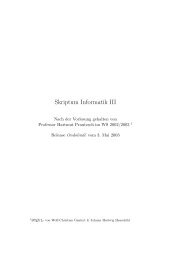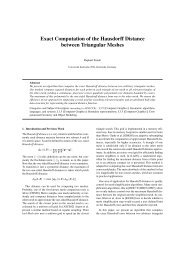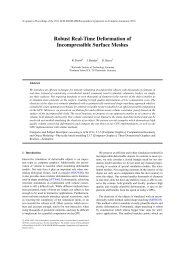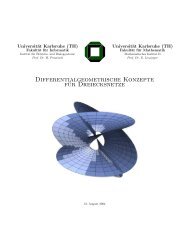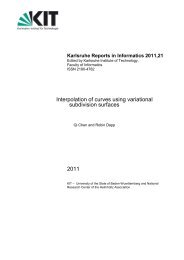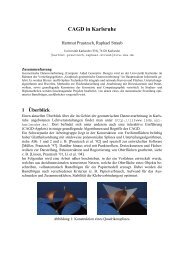On the Convergence and Correctness of Impulse-Based Dynamic ...
On the Convergence and Correctness of Impulse-Based Dynamic ...
On the Convergence and Correctness of Impulse-Based Dynamic ...
Create successful ePaper yourself
Turn your PDF publications into a flip-book with our unique Google optimized e-Paper software.
- 12 -<br />
PMSs can be imagined where <strong>the</strong> iterative correction <strong>of</strong> velocity does not converge even though<br />
Rank( M ) = m is true, since <strong>the</strong> iterative procedure <strong>of</strong> velocity correction solves <strong>the</strong> SLE with a<br />
variant <strong>of</strong> <strong>the</strong> Gauß-Seidel method, which does not guarantee convergence even if <strong>the</strong> SLE can be<br />
uniquely solved. It is <strong>the</strong>refore appropriate to solve <strong>the</strong> SLE for <strong>the</strong> velocity correction noniteratively.<br />
This also has <strong>the</strong> advantage that <strong>the</strong> parameter v max is <strong>of</strong> no use anymore. The matrices<br />
M are usually sparse <strong>and</strong> <strong>the</strong>refore permit faster solutions <strong>of</strong> <strong>the</strong> equation systems, see [Baraff<br />
1996] for details.<br />
5. Integration steps by Newton’s method<br />
To carry out an integration step, we usually assume that <strong>the</strong> PMS is in a consistent state (time t = 0)<br />
<strong>and</strong> has to be simulated in <strong>the</strong> forward direction for a time interval <strong>of</strong> length h . However, this<br />
condition is not always satisfied if higher order formulae [Schmitt et al. 2005] are used. In <strong>the</strong>se<br />
cases we start with a purely ballistic forward motion with time intervals <strong>of</strong> length h/2, h/3, h /4<br />
etc. The resulting dynamic state is nei<strong>the</strong>r D-consistent nor V-consistent. It is <strong>the</strong>refore necessary to<br />
examine <strong>the</strong> general case <strong>and</strong> not to assume that D-consistency or V-consistency exists. In <strong>the</strong><br />
following, we do not deal with halve stepping as described above but always use full time steps <strong>of</strong><br />
length h as it was done in (2.6).<br />
Without <strong>the</strong> application <strong>of</strong> correction impulses <strong>the</strong> motion is ballistic (see also (2.5)):<br />
2<br />
(5.1) Pr( h): = Pr(0) + h⋅ P& r(0) + 0.5 grh = LA( Pr(0), h)<br />
Using <strong>the</strong> abbreviation A ( h): = ( P ( h) − P ( h))<br />
we introduce <strong>the</strong> constraint functions<br />
k jk ik<br />
k k k<br />
2 2<br />
k<br />
f ( X): = ( A ( h) + h⋅∆w ( X)) − d ( k = 1,2,..., m)<br />
.<br />
We have to determine impulse strengths ( 1, 2,...,<br />
) T<br />
X = x x xmwhich,<br />
when applied at time t = 0,<br />
satisfy <strong>the</strong> following equations<br />
(5.2) fk ( X) = 0 ( k = 1,..., m)<br />
at time t = h.<br />
This is because f k already includes <strong>the</strong> additional velocities caused by <strong>the</strong> still unknown impulses<br />
(terms ∆ wk( X)<br />
) which should establish D-consistency again at time h .<br />
In order to calculate an approximate solution X for <strong>the</strong> system (5.2) <strong>of</strong> quadratic equations, we<br />
apply a step <strong>of</strong> Newton’s method with <strong>the</strong> start value 0 (0,0,...,0) T<br />
X = . With <strong>the</strong> m× m matrix<br />
(Jacobi matrix)<br />
⎛grad( f1( X )) ⎞<br />
⎜ ⎟<br />
⎜<br />
grad( f2( X ))<br />
⎟<br />
(5.3) M( X)<br />
: = ⎜..... ⎟,<br />
⎜ ⎟<br />
⎜..... ⎟<br />
⎜grad( fm( X )) ⎟<br />
⎝ ⎠<br />
where <strong>the</strong> gradient is defined by



